#alvarezsaurid dinosaur
Text
Dinofact #108
Albertonykus is the earliest and smallest known North American alvarezsaurid dinosaur. It measured 1.1 m (3.6 ft) long and weighed only 5 kg (11 lb). Albertonykus is also one of few alvarezsaurid dinosaurs found outside of South America and Asia.
Source: Wikipedia
#dinosaur#dinosaurs#paleontology#albertonykus#north america#north american dinosaurs#alvarezsaurid#alvarezsaurids#alvarezsauridae#alvarezsaurid dinosaur#alvarezsaurid dinosaurs#fun facts#trivia#dinosaur fun facts#dinosaur trivia#23rd#december#2022#december 23rd#december 2022#december 23rd 2022#records
5 notes
·
View notes
Text



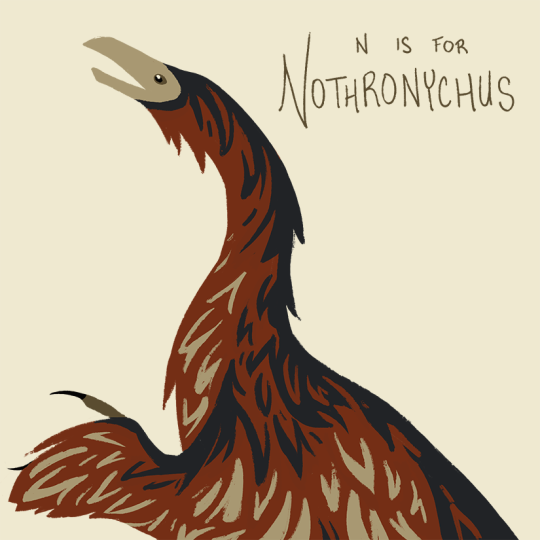

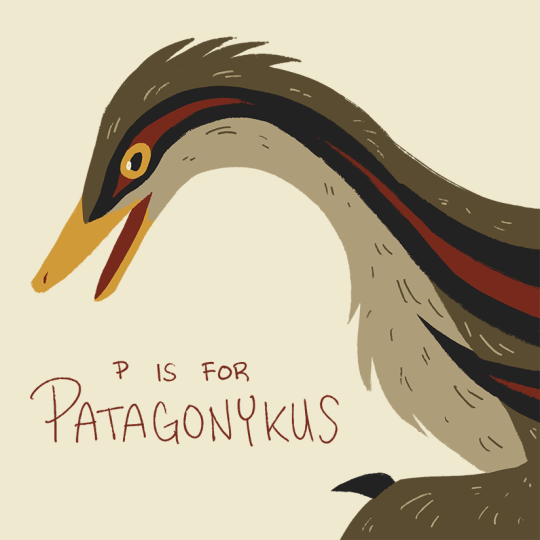
The Maniraptoran Alphabet (Part 3)
Part 3/5 of my dinosaur alphabet! Some of my favorite species in the whole set in this batch, but I'll let you guess which ones those are :)
#dinosaur#alphabet#maniraptoran#oviraptorid#alvarezsaurid#dromaeosaurid#therezinosaurid#khaan#linhenykus#microraptor#nothronychus#oviraptor#patagonykus#paleoart#illustration#artaneae
75 notes
·
View notes
Photo

One for the fans of Mononykus from Prehistoric Planet Season 1. Hooked claws, night vision, tails for turning, shrinking size... What have we learned about alvarezsaurs in the last three years?
149 notes
·
View notes
Text
Jaculinykus yaruui Kubo et al., 2023 (new genus and species)
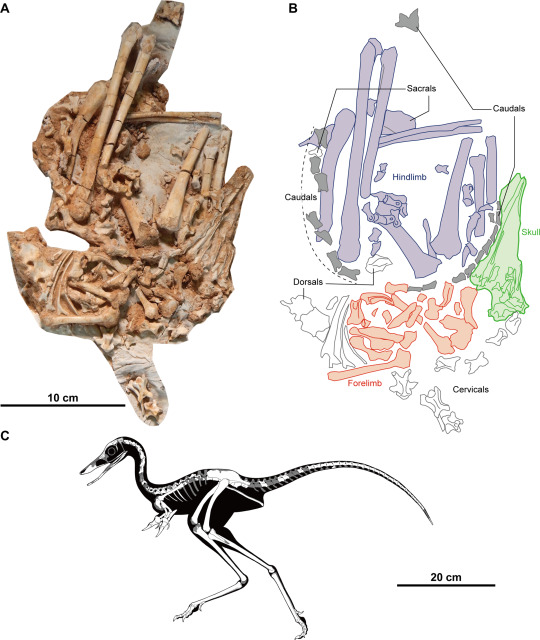
(Type specimen and schematic skeletal of Jaculinykus yaruui, with preserved bones in white on the skeletal, from Kubo et al., 2023)
Meaning of name: Jaculinykus = jaculus [small dragon in Greek mythology] claw [in Greek]; yaruui = speedy [in Mongolian]
Age: Late Cretaceous (Campanian–Maastrichtian?)
Where found: Barun Goyot Formation, Ömnögov, Mongolia
How much is known: Nearly complete skeleton of one individual.
Notes: Jaculinykus was an alvarezsaurid, a group of unusual small theropods with short but powerful forelimbs, each tipped with an enlarged thumb claw. Their other fingers were highly reduced, and in at least one case (Linhenykus), probably lost entirely. Jaculinykus appears to exhibit an intermediate stage in finger loss, having lost one of the smaller fingers on each hand. This makes it the first known example of an alvarezsaurid with two-fingered hands.
Jaculinykus is also one of the most completely known alvarezsaurids. Most of the bones in the type specimen have probably remained close to the original positions that they were held in when the dinosaur died, and they suggest that Jaculinykus slept in a very bird-like posture with the head turned back and tucked close to the body. A similar sleeping pose had previously been found in the troodontid theropods Sinornithoides and Mei, but Jaculinykus provides the first strong evidence that alvarezsaurids (which were more distant relatives of modern birds than troodontids) adopted the same behavior.
Reference: Kubo, K., Y. Kobayashi, T. Chinzorig, and K. Tsogtbaatar. 2023. A new alvarezsaurid dinosaur (Theropoda, Alvarezsauria) from the Upper Cretaceous Baruungoyot Formation of Mongolia provides insights for bird-like sleeping behavior in non-avian dinosaurs. PLoS ONE 18: e0293801. doi: 10.1371/journal.pone.0293801
366 notes
·
View notes
Text
Bannykus vs Ambopteryx
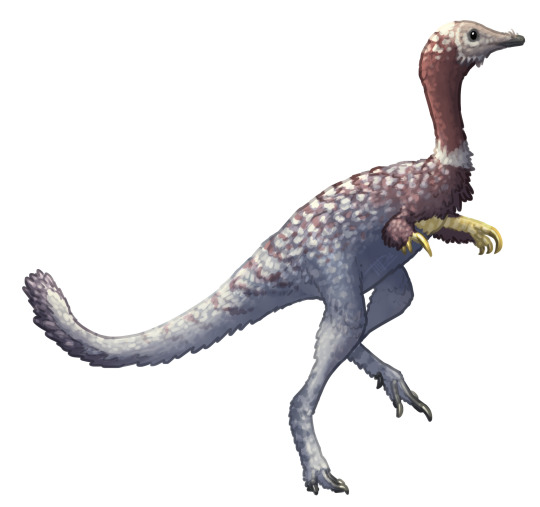

Factfiles:
Bannykus wulatensis

Artwork by @i-draws-dinosaurs, written by @i-draws-dinosaurs
Name meaning: Half claw from Wulatehouqi
Time: 113 to 100 million years ago (Albian stage of the Early Cretaceous)
Location: Bayin-Gobi Formation, Inner Mongolia, China
If there’s one group of dinosaurs that has most recently gained more fame among casual dinosaur fans it’s probably alvarezsauridae, elevated to stardom by the Mononykus that captured everyone’s hearts in Prehistoric Planet. The bizarre group of single-clawed maniraptorans has been studied for a while, but their evolutionary origins have fairly mysterious until recently. How did that whole giant thumb claw thing happen??
Published in 2018 alongside more basal alvarezsaur Xiyunykus, Bannykus helps to fill in a gap in that evolutionary pathway! More specifically, they help to fill in a 70 million year long gap between the primitive Late Jurassic Haplocheirus and the very end of the Cretaceous! Notably, Bannykus has a larger thumb claw that the rest of its claws, but the other fingers are at least partially functional instead of just nubbins. It’s a lot easier to see how the later alvarezsaurids got to where they are from here! Next time you lose your mind over the Mononykus from Prehistoric Planet (which I do at least weekly), say a thank you to the lil guy with slightly less weird hands. Thumbs up to Bannykus!
Ambopteryx longibrachium

Artwork by Gabriel Ugueto, written by @i-draws-dinosaurs
Name meaning: Both wings with long arms
Time: 163 million years ago (Callovian stage of the Middle Jurassic)
Location: Haifanggou Formation, China
Look, evolution has done a lot of weird stuff to dinosaurs. It put penguins underwater, and did whatever the hall mamenchisaurid necks are, and game lambeosaurs a built-in face trumpet. But I would argue there is one group that represents dinosaur evolution at its most unhinged, and that is scansoropterygidae.
Scansoriopterygids were generally considered “weird little tree dinosaurs” in the 2000s, with long fingers to pick grubs out of bark or something. Then Yi qi swept along in 2015 and revealed that those long fingers were actually supporting membranous bat wings. With an extra bony rod (the “styliform element”) sticking out of the wrist to help support it, because well if you’re a dinosaur evolving bat wings why bother being normal about it after that? Although really, the dinosaurs did it first so bats actually have dinosaur wings.
Yi was sensational, but it was also extremely weird and completely unique. Even other scansoriopterygids didn’t have wing membranes, so the whole bat thing was a bit up in the air. Or not up in the air, as the case may be. But then along comes Ambopteryx, published in 2019, packing another set of skin wings, and the vindication of Yi is complete!
Ambopteryx preserves a styliform element and wing membrane, as well as a thick coat of feathers, and honestly out of a whole selection of dinosaurs I think these might be some of the most huggable in the lot. Obviously this whole wing membrane thing didn’t end up working out for them long term, but Ambopteryx is part of an incredible lineage that challenged what we thought was possible for dinosaurs!
DMM Round One Masterpost
#dmm#dinosaur march madness#dinosaurs#paleontology#dmm round one#dmm rising stars#palaeoblr#bracket#march madness#polls#bannykus#ambopteryx
338 notes
·
View notes
Photo

Albertonykus
Albertonykus is a theropod alvarezsaurid dinosaur from the Late Cretaceous of Horseshoe Canyon Formation in Canada. It had specialized claws for digging termites inside rotten wood.
License this stock resource at: https://paleostock.com/resource/albertonykus-stock-photo
Illustration by @paleoart
#paleoart#sciart#science#nature#paleontology#geology#fossil#fossils#evolution#art#illustration#paleostock
166 notes
·
View notes
Note
my Name issue: portugal has a dinosaur, a sauropod, named Zby. Just Zby. Not Zbysaurus, not Zbydon, not ZbyWhateverSuffix, no. Just. Zby. Just. Freaking. Zby. Three letters. Id wager its the shortest, and dumbest, name.
Honestly, I gotta disagree with you I really like Zby. It's short and punchy and unique and idk it has a kind of cute charm to it I think.

(Life reconstruction of Zby by @alphynix)
My one issue is that I cannot seem to find an authoritative pronunciation guide, I hear people pronounce it "zee-bee" in videos but like that can't possibly be right, right? Like it's named after Georges Zbyszewski, which I believe is a Polish name and I don't know much about Polish pronunciation but I highly doubt it's pronounced "zee-bee" in that name.
My instinct would be to pronounce the dinosaur Zby as just those letters, no "zee" added in. If anyone out there speaks Polish I'd love to know if that's right or not!
(Also officially the shortest dinosaur genus name is actually Yi, the scansoriopterygid with kinda bat-like wings! It shares the distinction of having a two-letter genus name with an actual bat named Ia. Zby is one of four non-avian dinosaurs with a three-letter genus, the others being the ceratopsian Beg, the alvarezsaurid Kol, and the troodontid Mei)
791 notes
·
View notes
Text

#Archovember Day 25 - Tylocephale gilmorei
The pachycephalosaurids are famous for their thick, armoured heads, but one dome rose above the rest. Living in Late Cretaceous Mongolia, Tylocephale gilmorei, while a medium-sized pachycephalosaur, had the tallest known dome head comparable to body size. This dome could sustain higher forces of impact than other pachycephalosaurids. Like other pachycephalosaurs it likely ate plants and insects, though it had serrations on its teeth that may have allowed it to eat tougher materials like seeds and nuts.
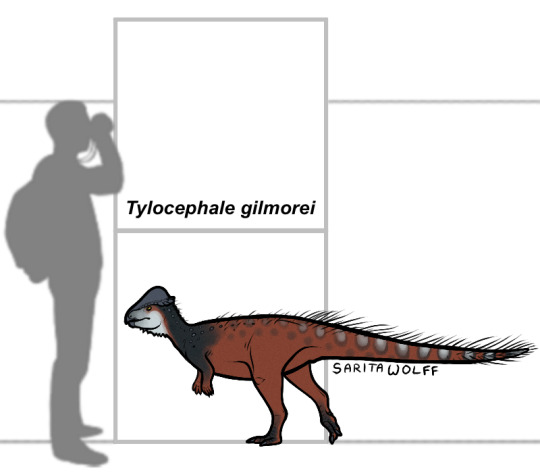
Tylocephale lived in an arid alluvial plain. It lived alongside a variety of other dinosaurs in the Barun Goyot Formation including ankylosaurs like Saichania, Tarchia, and Zaraapelta, protoceratopsids like Bagaceratops and Breviceratops, the titanosaur Quaesitosaurus, dromaeosaurs like Kuru and Shri, halszkaraptorines like Hulsanpes, oviraptorids like Conchoraptor, Heyuannia, and Nemegtomaia, alvarezsaurids like Khulsanurus and Parvicursor, and birds like Gobipipus, Gobipteryx, and Hollanda.
#my art#SaritaDrawsPalaeo#Tylocephale gilmorei#Tylocephale#pachycephalosaurs#pachycephalosaurids#ornithischians#dinosaurs#archosaurs#archosauromorphs#Archovember#Archovember2023
17 notes
·
View notes
Note
I would love to see more tiny dinos
Alrighty!
The tiniest non-avian dinosaur was Parvicursor remotus (shown below in green, in comparison to other alvarezsaurids), who's name means "small runner". This little fella measured just 15 inches (1.28 ft) from nose to tail! and is estimated to have weight just 162 grams (5.7 ounces)!

[ art source ]
90 notes
·
View notes
Text
A new alvarezsaurid dinosaur (Theropoda, Alvarezsauria) from the Upper Cretaceous Baruungoyot Formation of Mongolia provides insights for bird-like sleeping behavior in non-avian dinosaurs
Published 15th November 2023
A newly described derived alvarezsaur, Jaculinykus yaruui, from the Late Cretaceous of Mongolia represented by a nearly complete and articulated skeleton with the preserved posture of a stereotypical avian-like sleeping position suggesting that the sleeping postures are a maniraptoran synapomorphy.
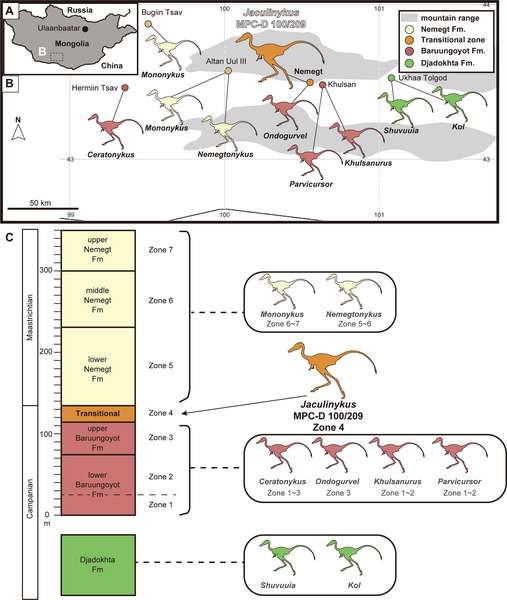
Geographic and stratigraphic occurrence of the Mongolian alvarezsaurids and Jaculinykus yaruui

Holotype of Jaculinykus yaruui and skeletal reconstruction

Evolution of avian-like sleeping posture in theropod dinosaurs, Skeletal disposition of Jaculinykus yaruui and life reconstruction
Source:
4 notes
·
View notes
Text
Dinofact #30
Shuvuuia, a small, bird-like alvarezsaurid from the late cretaceous, is unique among non-avian theropods, in that it can flex its upper jaw independently of its braincase - something that most other non-avian theropods cannot do.
Source: wikipedia [1], [2]
#dinosaur#dinosaurs#paleontology#shuvuuia#alvarezsaurid#alvarezsauridae#alvarezsaurids#theropod#theropods#theropoda#non-avian theropod#non-avian theropods#prokinesis#cranial kinesis#fun facts#trivia#dinosaur trivia#dinosaur fun facts#23rd#september#2022#september 2022#september 23rd#september 23rd 2022
10 notes
·
View notes
Text
@thesafaribaggirl-returns liked for a dinosaur fun fact!
"Have you ever heard of the alvarezsaurids? Talk about some little weirdos! They had these really small and stout forelimbs that only had one big claw. There was some really weird 'tiny arm' competition going on with theropods, lemme tell you."
2 notes
·
View notes
Text
I’m gonna share with you all some of my most favorite Dinos! They are all precious little babies and I love them more than anything in the world. And I wish I could give them all a hug and a forehead kiss and little snuggles.
The obvious is velociraptors! I don’t think I have to show you what those look like, lol.
Carnotaurus:
These bad boys were Theropods! They lived in South America around the late cretaceous period. They were carnivorous and suspected to be one of the fastest large theropods that ever lived.
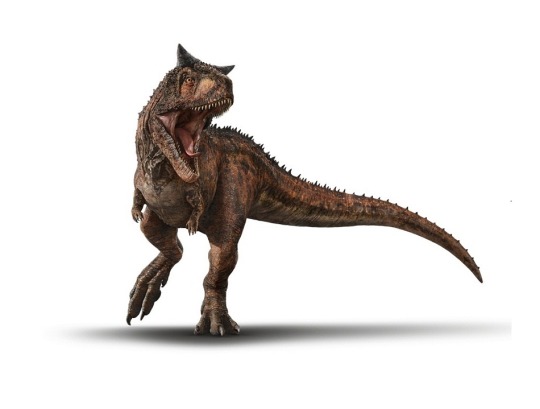
Therizinosaurus:
Also a member of the late cretaceous period, Therizionsaurs' were a large genus of Therizinosauridae. They lived in the Asia area. Their most distinctive feature would be their gigantic claws. They adapted to live an omnivorous lifestyle.

Ceratosaurus:
These fellas were carnivorous theropods in the late Jurassic Period. They had a larger horn in the middle of their snots, and two smaller horns over their eyes. It was unlikely their nasal horns were used as weapons, but more as a display to seem more threading. They likely preyed on herbivores.
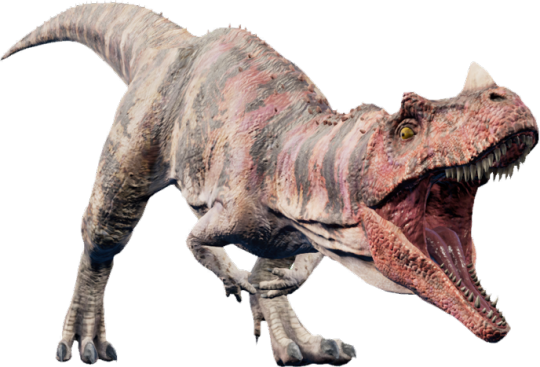
Baryonyx:
Back to the early cretaceous period, baby! Specifically the Barremian stage of the cretaceous period. Another species of theropod, the first skeleton was discovered in England. Baryonyx means “heavy claw” and these beasts are now recognised in the Spinosauridae family. They were the first dinosaur discovered to be fish-eating, and they had semi-aquatic habits.

Linhenykus:
Fancy, fancy, these are Alvarezsaurid theropods, also belonging to the late cretaceous period, found in Mongolia, China! They are the only known non-avian dinosaurs to have a single digit, aka one finger. They were small-bodied and would use their “finger” to dig for things like ants and termites. I just love how derpy they look with their little fingers.

Gigantoraptor:
Finally a non-theropod, we have an oviraptorosaur on our list. Found in Asia in the late cretaceous period, the first remains were found as recently as 2005! They were less likely to have grown feathers than other raptor species. They were bipedal omnivores and died younger than other larger theropods. The bottom half of their beaks were lacking in teeth.

Jeholopterus:
Back in the late Jurassic period, we have these small anurognathid pterosaurs. They were also found in Mongolia, China and were preserved with the skin! That’s crazy! Originally considered to be insect-eating, they also preyed upon fish and even omnivores They were nicknamed “Vampire Dinosaurs” Because they drank the blood of the other dinosaurs. I think it’s obvious why I enjoy them.

Spinosaurus:
Their name literally means “Spiney Lizard” which makes them certified babies in my book. And what do you know, they are classified as Spinosaurids. They were in the North African area, during the Cenomanian and Turonian stages of the late cretaceous period. They are the largest know terrestrial dinosaurs! They were fish-eating and also hunted terrestrial prey. Obviously, their most well-known feature was their Spines, and they were so pretty! Their high bone density allowed for better buoyancy, and their tails allowed for faster propulsion underwater. Their dorsal sails were used for thermoregulation, but it's unknown whether they were also used to intimidate other predators or to draw in mates. I give them ten “spiney boys” out of ten!

Quetzalcoatlus:
Similar to the word: hippopotomonstrosesquippedaliophobia, Quetzalcoatlus, is just really fun to say. Great vocal stim! They were Pterosaurs found in North America during the late cretaceous period. They’re members of the Azhdarchidae family, which are toothless pterosaurs with long, stiff necks. They ate fish and carcasses of titanosaur sauropods. They were INSANELY tall, like freakishly so. As much as I love their funny-looking heads, this is a dino I would run the other way from if it approached me. In fact, I think I’d be more scared of most pterosaurs than any other predator front that time period, because what the fuck?
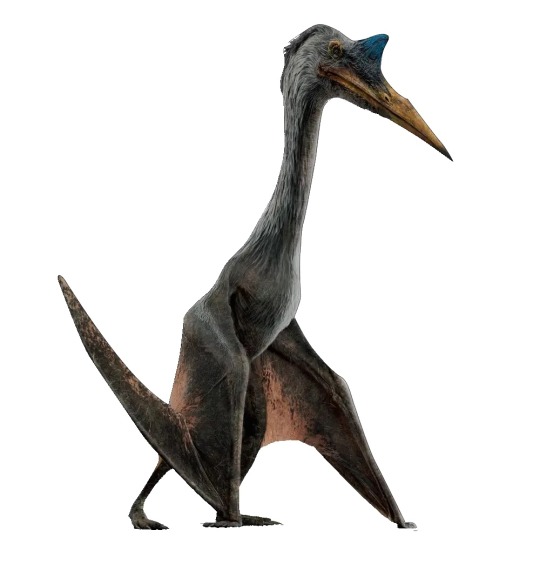
Ichthyosaurs:
And last, but certainly not least, because this app only allows ten photos per post, we have these little ocean boys. Onto the only reptile on my list, they were found during the Mesozoic era of the late cretaceous period. Their skeletons were first found in Egland. They look most similar to modern-day dolphins. Which, I am terrified of those little fuckers by the way, no not the ancient distinct reptiles, fucking dolphins! Rode one once, never again. This is another species I like solely for its looks, it's so dumb-looking and I want a plushie of them.

Did I just spend way too much time basically writing a mini-essay on dinosaurs? Maybe? Should I be asleep right now? My therapist would say yes. Am I now gonna go watch video essays on more dinosaurs to finish calming down my brain for the night? Yes again! I also forgot to eat dinner tonight because I was so upset, so I'm gonna et up and make dinner for breakfast in the morning, so I can have something more nutritious than cereal. Let me know if you guys wanna hear about more Dinos or my other special interests!
#dinosaur#dinos#favorite dinosaur#fangs faves#learn with fang#autism special interest#hyperfixaton#prehistoric life
16 notes
·
View notes
Text
I've never quite realised just how much the dinosaurs flourished in the Cretaceous as I have since I started tagging the period animals are from when I post stuff on Tumblr. Seriously, there are so many groups where, no matter whether I know the species or not, I can blindly tag it as #cretaceous because that group just wasn't around yet in the Jurassic. Dromaeosaurs, Tyrannosaurs, Oviraptorosaurs, Ornithomimosaurs, Ceratopsians, Pachycephalosaurs, Alvarezsaurids, Hadrosaurs, and probably more are all exclusively Cretaceous. It's especially interesting considering when growing up, I was told that the Triassic was the rise of the dinosaurs, the Jurassic was when they were at their most spectacular, and the Cretaceous is when they slowly declined towards their extinction. But even if there was pre-meteorite decline (the evidence for which I don't find compelling at all outside of specifically North America) it would have occurred right at the very last million years or so of the Cretaceous, with the rest of the period being an absolute crescendo of the dinosaurs.
#cretaceous#jurassic#sorry jurassic#stegosaurs are cool and you have a lot of sauropods#but even those get bigger in the cretaceous#you got some really cool early avialans#but the cretaceous kind of ends up outdoing you on those too#not to mention actual proper crown birds#palaeoblr
5 notes
·
View notes
Text
Episode 470: Life on Our Planet review and a new sleeping alvarezsaurid
I Know Dino Podcast Episode 470: Life on Our Planet review and a new chest-clawed alvarezsaurid that fossilized while curled up to sleep.
Episode 470: Life on Our Planet review and a new sleeping alvarezsaurid. We discuss all the VFX dinosaurs from Netflix’s Life on Our Planet. Plus a remarkably complete new chest-clawed alvarezsaurid that fossilized while curled up sleeping
News:
A new alvarezsaurid, Jaculinykus, which is named after a “javelin snake” dragon from Greek mythology source
A review of Netflix’s Life on Our Planet,…
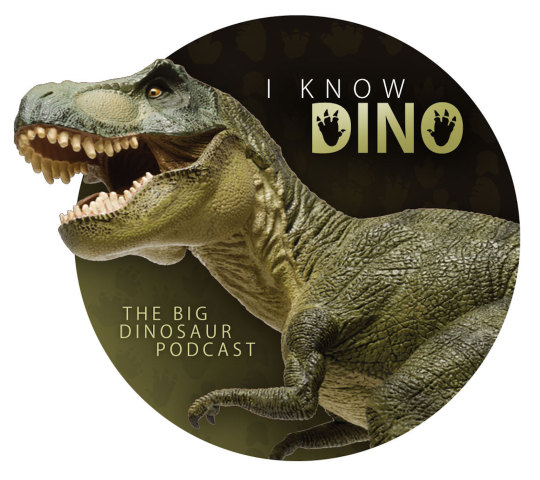
View On WordPress
0 notes